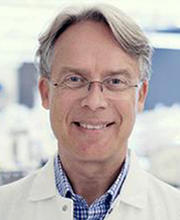Ole Isacson, M.D.
Harvard Medical School

Dr. Ole Isacson and the Neuroregeneration Research Institute (NRI) at McLean Hospital are at the forefront of research into regenerative medicine for brain disorders.
The Neuroregeneration Laboratories and Institute have an impact on several neurodegenerative disease problems. Studies indicated in the early 90s that cells vulnerable to the disease processes in Parkinson’s or Huntington’s disease could be protected from various toxins, including lesions and energetic metabolic failures (Schumacher et al. 1991, Frim et al. 1994). Work also showed that neurons in the striatum could be replaced by implanted fetal GABAergic neurons with functional effects (Hantraye et al. 1992) and that these cells could also grow in Huntington patients in an appropriate way (Freeman et al. 2000).
Dr. Isacson's lab was the first to demonstrate that normal midbrain dopaminergic neurons could develop from uninduced embryonic stem cells in 1998 (Deacon et al 1998). This work led to the first demonstration of functional dopamine neurons transplanted to animal models of Parkinson's disease by Dr. Isacson's research group in 2002 (Bjorklund et al. 2002).
Parkinson’s disease cell transfer work revealed that many different kinds of deficits could be repaired by fetal neurons, even when donor cells were from different donor species. For example, the Isacson lab demonstrated in both animal models and clinical studies that in principle, these cells can repair the dopamine system (Isacson et al. 1995, Deacon et al. 1997, Mendez et al. 2005). These studies demonstrated that functional repair is possible using cell therapies, either for trophic preservation or by restituting the neurotransmission. Dr. Isacson's lab was the first to transplant embryonic stem cell derived gamma-aminobutyric acid (GABA) expressing neurons in animal models in 1995 (Dinsmore et al. 1996). Scientists at the Neuroregeneration Laboratories first demonstrated that embryonic stem cells and iPS cells can also generate the dopamine neurons (A9 and A10) that are involved in the degeneration that creates the syndrome of Parkinson’s disease (Deacon et al. 1998, Bjorklund L et al. 2002, Hargus et al. 2010, Hallett et al. 2014, 2015). These discoveries show that ES and iPS cell derived neurons, including human cells, can reverse functional deficits in animal models and patients and create neurotransmission that involves basal ganglia, motor circuitry and behavioral recovery (Hallett et al, 2014, 2015.)
Another complementary approach involves defining the molecular profile of vulnerable neurons in neurodegenerative disease. This has generated new molecular targets efficiently for neuroprotective treatments (C.Y. Chung et al. 2005, 2010, Hedlund et al 2010, Rocha et al. 2015) in neurodegenerative diseases.
Innovative axon and synapse regeneration approaches (Lin et al. 2006, 2009, Inoue et al. 2007, Korecka et al. 2016), novel neural cell sorting methods (Pruszak et al. 2007, 2009, Cooper et al. 2010), genetic engineering and gene therapy (Seo et al. 2007, C.Y. Chung et al. 2007, 2009, Hemming et al. 2007, Rocha et al. 2015, Jeon et al 2016) complement the in vivo studies to achieve realistic goals in regenerative medicine for patients with neurological diseases.
The Neuroregeneration Research Institute (NRI), where Isacson is founding director, has provided novel technology and biological insights beyond currently available drug therapies.
Biosketch
Dr. Ole Isacson, founding Director of the Neuroregeneration Research Institute at McLean Hospital, is Professor of Neurology (Neuroscience) at Harvard Medical School, Professor of Neurology at Massachusetts General Hospital, and an NIH Udall Parkinson's Disease Research Center of Excellence grant awardee.
Isacson received his Medical Bachelor and Doctor of Medicine (a research doctoral degree in Medical Neurobiology, 1987) from the University of Lund in Sweden. After a two-year postdoctoral position at the University of Cambridge, Dr. Isacson was recruited to Harvard as an assistant Professor of Neuroscience and established a small, independent research laboratory for his work on neuroregeneration. Since then, his original laboratory has grown to an internationally recognized academic research center for Parkinson's disease and related disorders, funded by the NIH, DOD and private foundations.
Isacson's scientific models and studies of conceptually new therapies for neurodegenerative diseases have resulted in many new findings and clinical trials for Parkinson's and Huntington's disease. He served as Editor In Chief of the journal Molecular and Cellular Neuroscience and is on the board of numerous scientific journals. He is a founding member and past President of the American Society for Neural Transplantation and Repair, and past President of the international Cell Transplantation Society (branch of the American Transplantation Society – AST). He serves as a reviewer and advisor to the NIH, DOD, FDA, Industry and many patient community groups, and has participated in several biotech start-ups as well as performed senior executive roles in industry. Isacson has received international prizes, research awards and lectureships, and was elected Fellow of the American Association for the Advancement of Science - AAAS (2014). He is the author or co-author of over 300 scientific research publications in neuroscience and neurology, and three books in his field.
